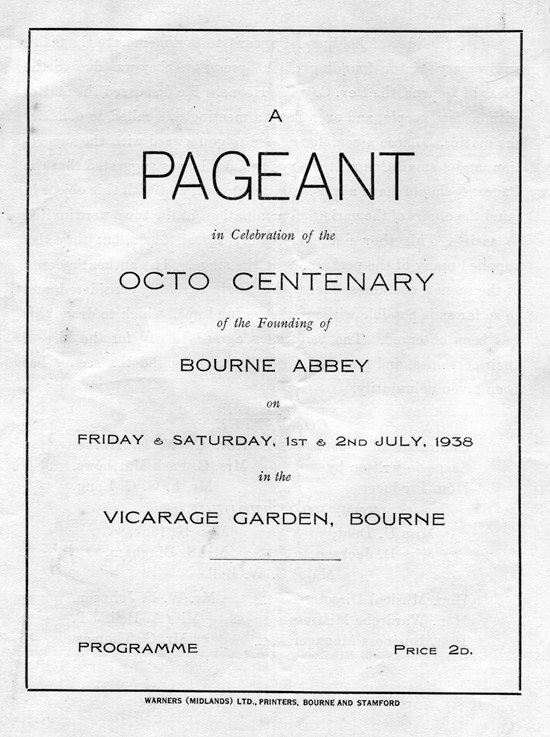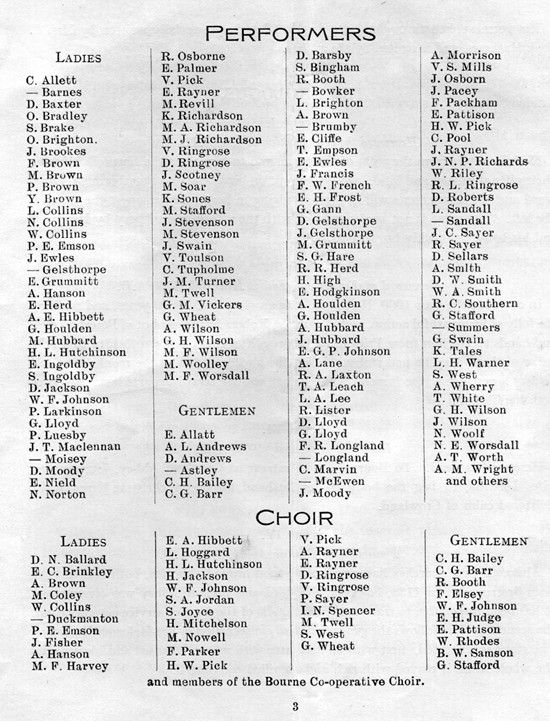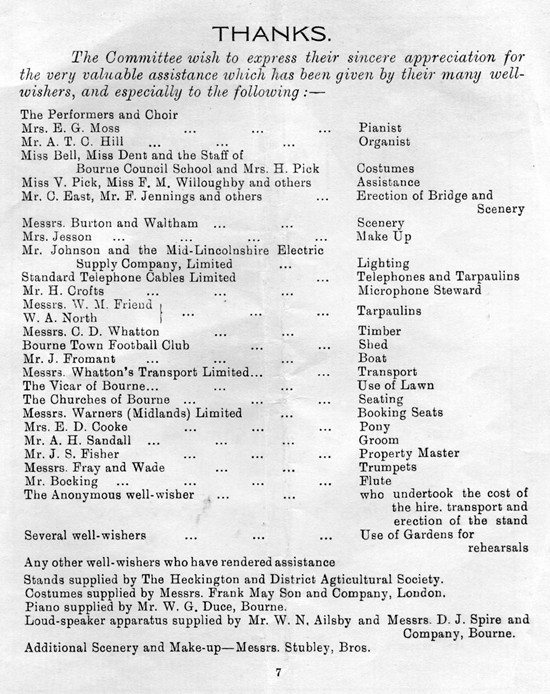|
The 800th anniversary
of Bourne Abbey
|
One of the great church celebrations of past
times was the Bourne Pageant which was held in the garden of the old
vicarage [now the Cedars retirement home] in 1938 to celebrate the
800th anniversary of the founding of the abbey by Baldwin
Fitzgilbert in 1138. There were two days of events, on Friday and
Saturday 1st and 2nd July, including a service which was held in the open
air with a fully robed choir while special stands were erected
around the lawn for the congregation. Details of the various reenactments staged by parishioners are reproduced below from the
actual programme and the photographs on that occasion were taken by
local photographer Ashby Swift. |
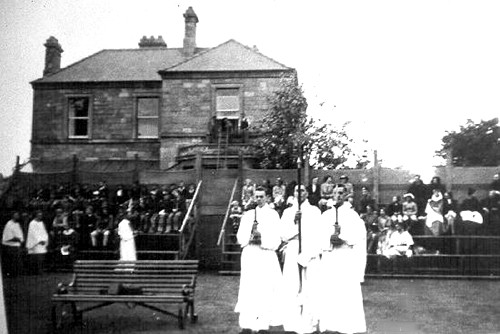
The idea of holding a pageant to
commemorate the 800th anniversary of the founding of the present Abbey was
due to the Vicar of Bourne, the Rev C W E Horne. He discussed the matter
with a few people, and eventually a meeting was called to consider the
matter. Those assembled agreed to go forward with the suggestion and a
small committee was formed. It was suggested that the pageant should have
a musical background, and with this object in mind the choirs of the
various denominations in the town were invited to assist. This they not
only readily agreed to do, but they also supplied many of the performers
on the stage. The authentic detail of the scenes, costumes, dances, etc.,
were carefully considered, and in so far as is possible without a large
fund upon which to draw, this has been observed. The performers agreed to
pay for the hire of their costumes, and practically all the work behind
the scenes has been given voluntarily.
COMMITTEE
Chairman - Rev C W E Horne
Scenario written by Mrs C Pask Matthews
Hon Producer - Mr. F G C Long
Hon sub producers - Miss U Dent, Mrs H Pick, Miss D Jackson, Mr S Bingham,
Major C W Bell
Hon Musical Director - Mr T F Johnson
Hon Wardrobe Mistress - Miss A Bell JP
Hon Business Manager Mr G Thomas
The verse spoken throughout the pageant has been specially written
by Mrs C Pask Mathews and is recited by the author.
Scene I: Hereward the Wake Outlawed 1040 AD.
Herluin enters from the right of the stage, and to him come the townfolk
bringing their gifts of money and kind. As he sets out on his journey to
Peterborough, Hereward and his companions will be seen indulging in
horse-play amongst the trees on the left. The scene is not prolonged, but
with the attack and robbery by Hereward and his band, is quickly brought
to a close.
Scene II: Hereward makes amends and is Knighted, 1060 AD.
In or about the year 1060, Hereward, now an older man by 20 years, and
realising the folly of his youthful action, seeks his uncle, Robert Brand,
Abbot of Peterborough, and hands to Herluin (now Prior of Peterborough) a
gold chain worth fifty times the value of the money he had stolen. From
the girdles of two of the monks his uncle devises a new crest (the famous
Wake Knot) and Hereward departs hence at peace with the Church.
Scene III: Death of Hereward 1071 AD.
Hereward is dead. To Bourne, out of retreat at Crowland Abbey, journeys
his wife, Torfrida, to beg the body of her husband for decent christian
burial in the cloistered calm of Crowland.
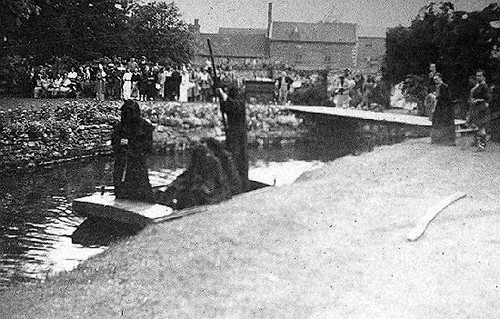
Scene IV: Founding of Bourne Abbey 1138 AD.
Although two churches had previously stood around this site, both had in
turn been destroyed. In 1138, however, the third and present Abbey was
commenced. It has been impossible to trace authentic details of the form
of service actually used, the scene therefore follows the general form of
consecration in Pre-Reformation times. The stone is anointed, first with
oil and later with water, is censed and blessed, and the whole scene is
played with rich and dignified ceremonial.
Scene V: Visit of King Edward III and Queen Philippa 1330 AD.
This scene brings a glimpse of the age of chivalry before our eyes; Edward
III and Queen Philippa being received by the Abbot of Bourne and Sir
Thomas Wake. The quiet grace and beauty of the scene must remain a
pleasing memory in the minds of the audience long after the performance.
Scene VI: Robert Manning (Robert of Bourne) writes the Chronicle of
England 1338 AD.
Robert Manning wrote the Chronicle of England while Magister of the Abbey
about 1338-40. This scene portrays the form of education given at that
time, novices and townsboys each in their allotted portions of the
cloisters receiving instruction from the monks. Manning finishes his great
work and amidst rejoicing, the treasured book is carried into the Abbey.
Scene VII: Abbot of Bourne accepts the Act of Supremacy 1536 AD.
The year 1536 was a dark one for the church. By order of King Henry VIII
all religious houses refusing to acknowledge the royal decree were closed,
the inmates driven forth, and their valuable treasures confiscated.
Faithful and gentle men of God bowed before the storm of ruthless King and
Nobles, and went forth into the land, but ever with their faith and
purpose undimmed.
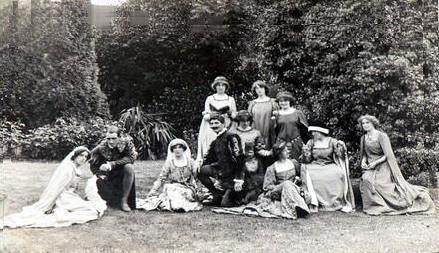
Scene VIII: Visit of Queen Elizabeth 1580 AD.
William Cecil, Lord Burghley, was born in the town at what is now the Bull
Hotel, then a private residence. In later years he rose to be one of
England's greatest statesmen. Tradition says that on one of his visits to
the town of his birth, he persuaded his sovereign to accompany him and
honour the town with her presence.
Townsfolk assemble to greet the Queen, the children performing two dances
for her pleasure. So well do they succeed that the royal visitor - whom
history tells us was also a devotee of this art - leads her court in a
further measure. (The dances here performed are amongst those dating back
to this period.)
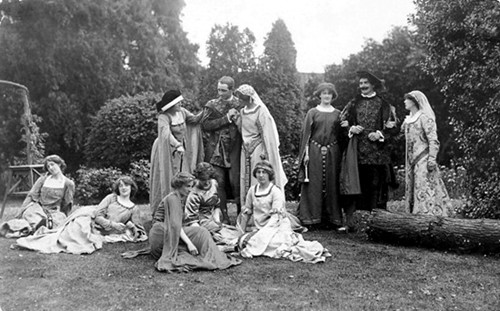
Scene IX: Finale
The Pageant is drawing to its close. The whole of the performers and the
choir gradually assemble upon the stage. The beautiful colourings of the
dresses set upon the tree-flanked arena makes a magnificent picture. The
choir sings a Chorale, after which the whole of the performers and choir
bring the Pageant to its close with the Pageant Hymn. The audience are
requested to rise and join in singing this hymn, as follows:
Thy Kingdom come on bended knee
The passing ages pray;
And faithful souls have yearned to see
On earth that Kingdom day.
And lo, already on the hills
The flags of dawn appear;
Gird up your loins, ye prophet souls,
Proclaim the day is near.
The day in whose clear-shining light
All wrong shall stand revealed
When justice shall be throned in might,
And every hurt be healed.
When knowledge, hand in hand with peace,
Shall walk the earth abroad;-
The day of perfect righteousness,
The promised day of God.
The Epilogue.
The Blessing.
God Save the King.
NOTE: The programme is reproduced
courtesy Jonathan Smith
The 800th anniversary
of Bourne Abbey
|
 |
|
A pageant to celebrate the 850th anniversary
was held in the Abbey Church in November 1988. There were a series
of 14 scenes depicting its history as follows:
Scene 1 - 1138: The
foundation of Bourne Abbey
Scene 2: Bourne Castle and Hereward the Wake
Scene 3: Robert Manning
Scene 4 - 1348: The Black Death
Scene 5: A ghostly tale
Scene 6 - 1536: The dissolution of Bourne Abbey
Scene 7 - 1600: A celebration at Burghley House
Scene 8 - 1644: Roundheads desecrate the Abbey Church
Scene 9 - 1750: The Old Grammar School: The Daily Test Chant
Scene 10 - 1856: The annual choirboys' outing
Scene 11 - 1914-18: The First World War
Scene 12 - 1939-45: The Second World War
Scene 13: Raymond Mays
Scene 14: Finale |
Return to The Abbey Church

Go to:
Main Index Villages
Index
|




